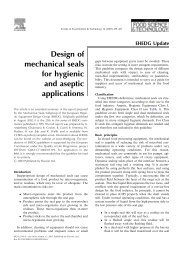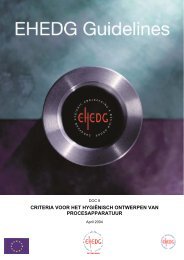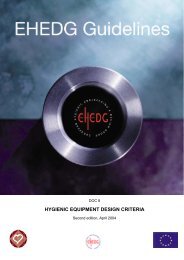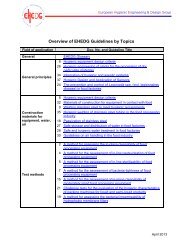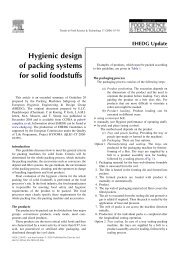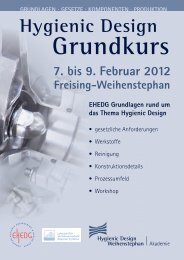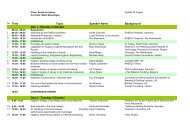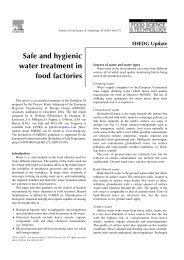Yearbook 2013/2014 - ehedg
Yearbook 2013/2014 - ehedg
Yearbook 2013/2014 - ehedg
Create successful ePaper yourself
Turn your PDF publications into a flip-book with our unique Google optimized e-Paper software.
32 Particle and VOC emissions, chemical and biological resistance, and cleanability<br />
Hygienic materials suitable for use<br />
in the food industry using the example<br />
of flooring systems<br />
All surfaces in a clean manufacturing environment that are<br />
in contact with the ambient air are capable of contaminating<br />
it. Consequently, they significantly affect the attainment<br />
and maintenance of a required degree of cleanliness. For<br />
example, if process water accumulates in the joint of a<br />
flooring system sealed with poor quality sealing material, any<br />
mould spores present could flourish there due to the good<br />
local growing conditions (humidity, temperature, nutrients)<br />
and become a major source of infection. If a material<br />
corrodes as a result of the effect of an aggressive cleaning<br />
agent, it not only loses its required material properties but<br />
may become a dangerous source of particulate emissions.<br />
Chemical influences may cause a flooring material to<br />
become brittle. If mechanical action is subsequently applied<br />
(transport rollers of a heavy preparation tank, etc.), cracks<br />
could form, representing a microscopic hazard because it<br />
would be impossible to remove or inactivate effectively any<br />
microorganisms accumulating in the cracks. Among others,<br />
this aspect was considered in the requirements of the EU-<br />
GMP Guideline Annex 1 illustrated in Figure 4:<br />
Extract from EU-GMP-guideline Annex 1:<br />
» … in clean areas, all surfaces should be smooth, imperious and unbroken in<br />
order to minimize the shredding or accumulation of particles or<br />
microorganisms and to permit repeated application of cleaning agents and<br />
desinfectants where used … «<br />
» … The manufacture of sterile products is subject to special requirements in<br />
order to minimize risks of microbiological contamination, and of particulate<br />
or pyrogen contamination.«<br />
Particle<br />
Biol. Resistance and<br />
Microbizidity<br />
Cleaning and<br />
Chem. Resistance<br />
Figure 4. Extract from EU-GMP Annex 1 with derivable material<br />
requirements.<br />
Therefore, flooring systems installed in a hygienic<br />
manufacturing environment need to be resistant to the<br />
chemicals used in cleaning and disinfection agents.<br />
Microorganisms may not colonise there or interact with them.<br />
Surfaces must be thoroughly cleanable. No substances may<br />
migrate from materials to the product and the material may<br />
not host any form of contamination. In some industries,<br />
material surfaces are treated with an antimicrobial agent.<br />
In such cases, it is not only important to be sure that the<br />
antimicrobial coating functions in practice but also that the<br />
material does not represent a hazard to human health in any<br />
way.<br />
Due to the large surface area and associated contamination<br />
risk of flooring systems, they are now discussed in more<br />
detail. First of all, the under-surface of a flooring system<br />
must be permanently sealable. Liquid residues from a<br />
previous cleaning or disinfection process may remain on the<br />
surface for a long time, making it extremely important for the<br />
system to be highly resistant to the chemicals used. To be<br />
able to clean edges and corners effectively, flooring must be<br />
laid so that it extends upwards to cover the bottom section<br />
of walls. The mechanical properties of the system must be<br />
designed to prevent damage from occurring as a result of<br />
typical stresses (e.g., rollers of transport trolleys, high point<br />
loads). To generally aid cleanability, roughness levels must<br />
be kept as low as possible. However, the need for a nonslip<br />
coating, if required, may not be forgotten in the process.<br />
Where possible, the transmission between floor and wall<br />
systems should be seamless.<br />
The biomaterial regulations in Annex 2 state that, for all<br />
protective categories, surfaces are to be impermeable to<br />
water and easy to clean. From Level 2 upwards, biomaterial<br />
regulations require adequate resistance to acids, alkalis,<br />
disinfection agents and solvents. 8<br />
In the case of reactive systems (e.g., epoxy resin floors),<br />
care must be taken to ensure that the outgassing of organic<br />
contamination is kept to a minimum in order to protect<br />
employees and, if sensitive processes are concerned, also<br />
the product. No critical airborne particulate contamination<br />
may be generated on subjecting the flooring system to<br />
tribological stress (e.g., rollers, stress due to walking,<br />
etc). Comparative tests need to be carried out on a wide<br />
range of materials to determine outgassing behavior and<br />
particulate emission due to tribological stress, and the<br />
results appropriately classified. 9,10 It must be possible to<br />
clean flooring systems effectively using dedicatedl cleaning<br />
methods and agents.<br />
Material and methods:<br />
Comparative tests to classify materials<br />
Particulate emission<br />
If a material is subjected to mechanical stress due to<br />
friction from another material, material abrasion in the form<br />
of particle generation occurs. This also can be caused by<br />
sliding friction from rollers or static friction from walking over<br />
a flooring system wearing shoes. To obtain comparative<br />
information about particulate emission from various flooring<br />
systems due to tribological stress (friction), a special<br />
tribological test bench has been constructed (Figure 5). It is<br />
operated in a Class ISO 1 reference cleanroom to eliminate<br />
measurement errors caused by potential foreign particles<br />
in the environmental air. 2 In the comparative classification,<br />
only sliding friction is considered. The counter sample<br />
used in the tests is a standardised polyamide-6 roller that<br />
simulates the sliding friction caused by transport rollers.<br />
Both applied force and angular velocity are kept constant.<br />
The laminar unidirectional airflow with a velocity of 0.45<br />
m/s, which flows from the cleanroom ceiling to the raised<br />
floor in accordance with ISO specifications for a Class 1<br />
cleanroom, ensures that particles generated during the test<br />
are transported downwards in a vertical direction towards<br />
the sampling probe installed downstream that detects<br />
the airborne particles (Figure 2). Using the principle of<br />
scattered light, a particle counter detects all particles with<br />
a diameter >0.2 µm and classifies the number of particles<br />
into predefined particle size channels according to their<br />
size. To take single events appropriately into account, the<br />
test is performed for a minimum of one hour. On cumulating<br />
the data and transforming coordinates, a result is obtained<br />
that gives an assessment of the test material with regard to<br />
particulate abrasion due to tribological stress. The procedure



